Understanding Habits A habit is a behavior repeated so frequently that it becomes automatic. The brain, ever efficient, loves to automate frequently repeated actions to conserve energy. This mechanism is why you can drive home without consciously thinking about every turn or brush your teeth while thinking about something entirely different. The formation of a habit follows a loop: cue → craving → response → reward. This neurological cycle governs everything from snacking at 3 PM to checking our phones the moment we wake up. Understanding this cycle allows us to consciously engineer habits that serve us—or break those that don’t. But here’s the kicker: the strength of a habit lies not in its size but in its repetition. A single push-up doesn’t get you fit, and one salad won’t transform your health. But repeated over weeks and months, these actions wield enormous influence. The Role of Identity One of the most profound insights in behavior change is the link between identity and habits. We tend to act in alignment with who we believe we are. This means that lasting change often requires a shift in self-perception. Consider two people trying to quit smoking. One says, “No thanks, I’m trying to quit,” while the other says, “No thanks, I’m not a smoker.” The second person has internalized a new identity. They are no longer someone resisting temptation—they are someone for whom smoking is simply not part of who they are. This concept works positively too. Want to become a writer? Start identifying as one. Not based on a published book, but on the simple, repeated act of writing. Identity builds through action, and the most effective way to change who we are is to change what we do—repeatedly. Understanding Habits A habit is a behavior repeated so frequently that it becomes automatic. The brain, ever efficient, loves to automate frequently repeated actions to conserve energy. This mechanism is why you can drive home without consciously thinking about every turn or brush your teeth while thinking about something entirely different. The formation of a habit follows a loop: cue → craving → response → reward. This neurological cycle governs everything from snacking at 3 PM to checking our phones the moment we wake up. Understanding this cycle allows us to consciously engineer habits that serve us—or break those that don’t. But here’s the kicker: the strength of a habit lies not in its size but in its repetition. A single push-up doesn’t get you fit, and one salad won’t transform your health. But repeated over weeks and months, these actions wield enormous influence. The Role of Identity One of the most profound insights in behavior change is the link between identity and habits. We tend to act in alignment with who we believe we are. This means that lasting change often requires a shift in self-perception. Consider two people trying to quit smoking. One says, “No thanks, I’m trying to quit,” while the other says, “No thanks, I’m not a smoker.” Th

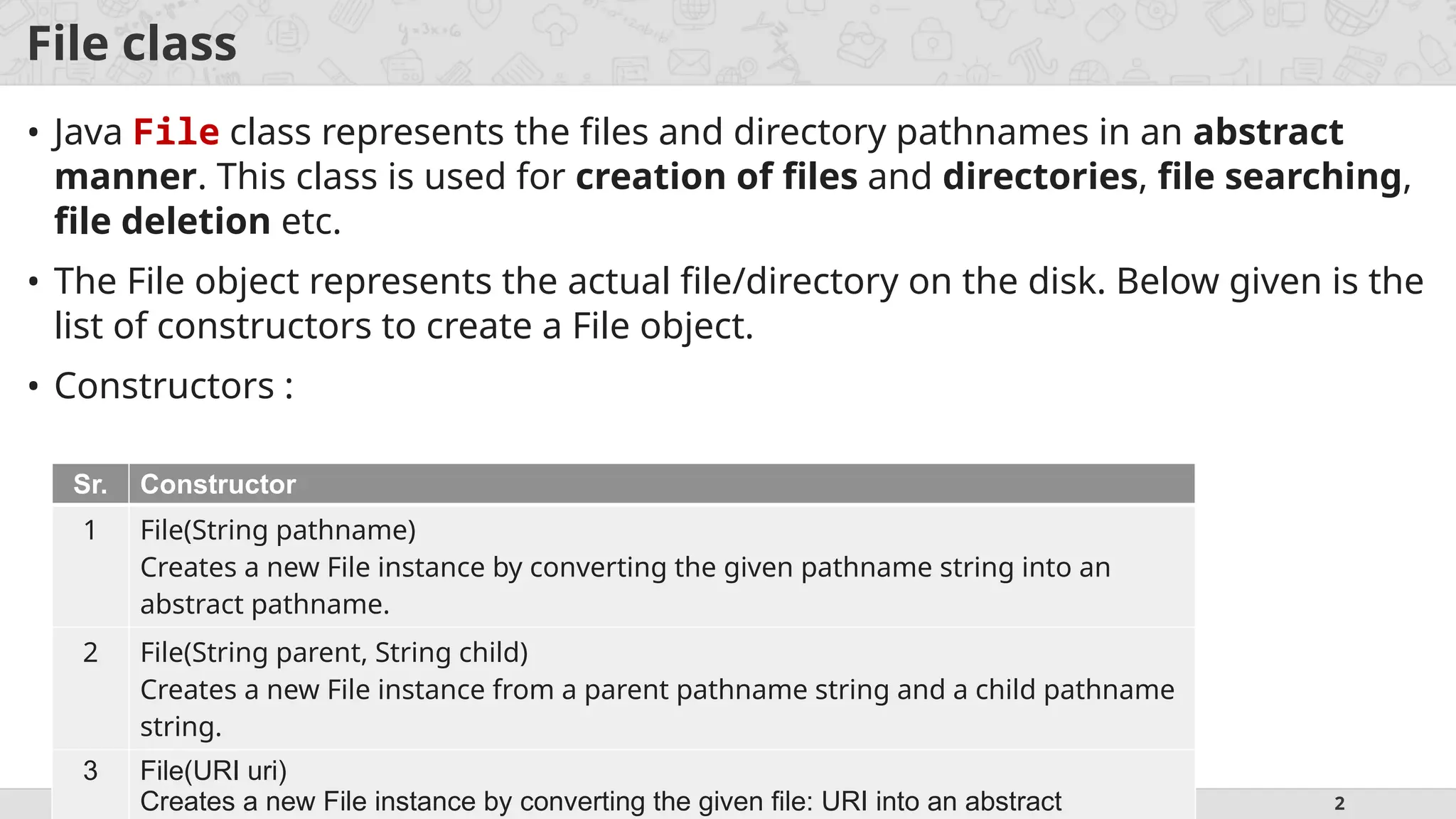
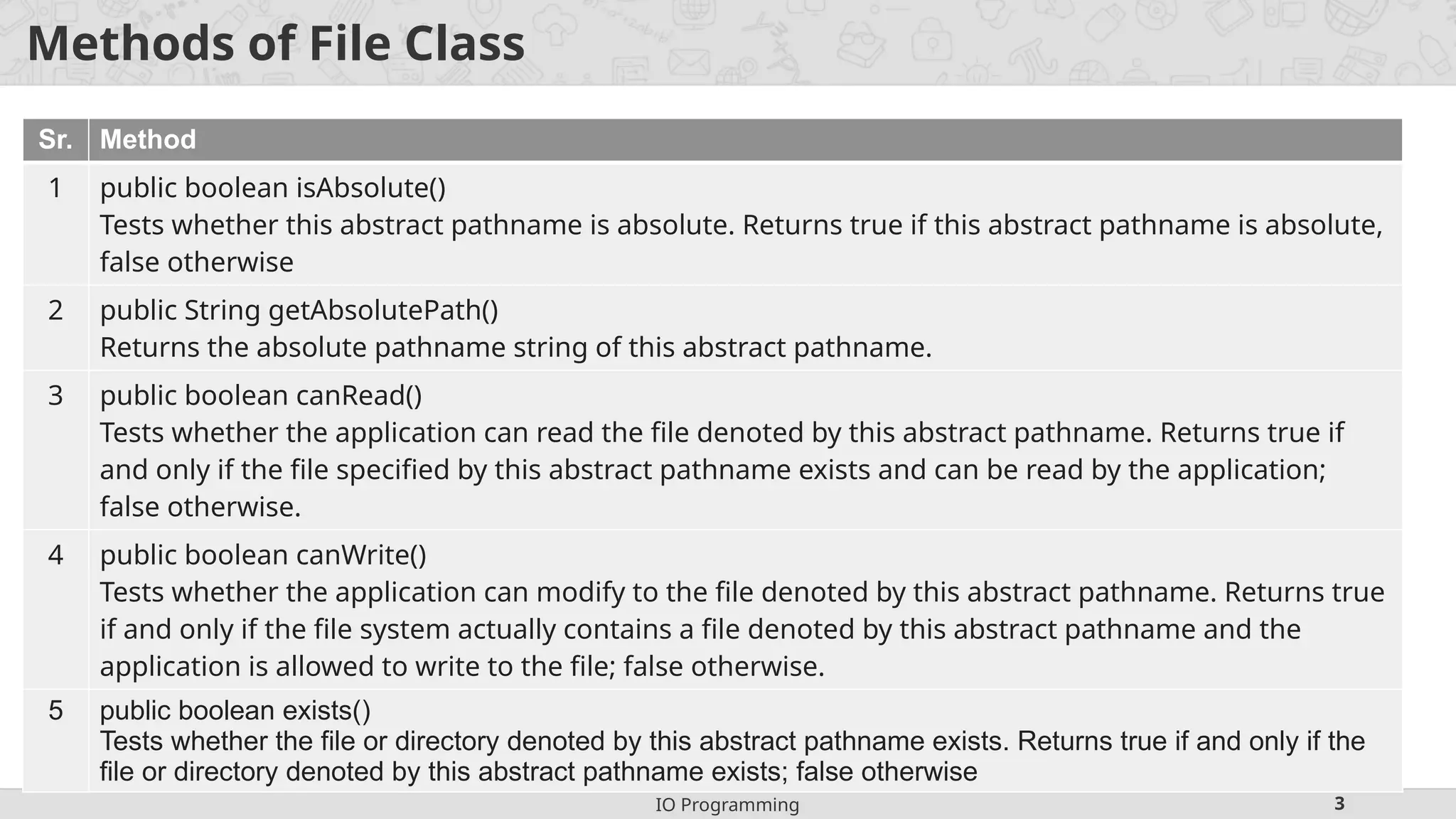
![IO Programming 4 Methods of File Class (Cont.) Sr. Method 6 public boolean isDirectory() Tests whether the file denoted by this abstract pathname is a directory. Returns true if and only if the file denoted by this abstract pathname exists and is a directory; false otherwise. 7 public boolean isFile() Tests whether the file denoted by this abstract pathname is a normal file. A file is normal if it is not a directory and, in addition, satisfies other system-dependent criteria 8 public long lastModified() Returns the time that the file denoted by this abstract pathname was last modified. Returns a long value representing the time the file was last modified, measured in milliseconds since the epoch (00:00:00 GMT, January 1, 1970). 9 public long length() Returns the length of the file denoted by this abstract pathname. 10 public boolean delete() Deletes the file or directory. 11 public String[] list() Returns an array of strings naming the files and directories in the directory denoted by this abstract pathname.](https://image.slidesharecdn.com/ioprogramming-250415020335-e414d173/75/IO-Programming-pptx-all-informatiyon-ppt-4-2048.jpg)
![IO Programming 5 import java.io.File; class FileDemo { public static void main(String args[]) { File f1 = new File("FileDemo.java"); System.out.println("File Name: " + f1.getName()); System.out.println("Path: " + f1.getPath()); System.out.println("Abs Path: " + f1.getAbsolutePath()); System.out.println("Parent: " + f1.getParent()); System.out.println(f1.exists() ? "exists" : "does not exist"); System.out.println(f1.canWrite() ? "is writeable" : "is not writeable"); System.out.println (f1.canRead () ? "is readable" : "is not readable"); System.out.println ("is " + (f1.isDirectory() ? "" : "not" + " a directory")); System.out.println(f1.isFile() ? "is normal file" : "might be a named pipe"); System.out.println(f1.isAbsolute() ? "is absolute" : "is not absolute"); System.out.println("File last modified: " + f1.lastModified()); System.out.println("File size: " + f1.length() + " Bytes"); } } File Class Example](https://image.slidesharecdn.com/ioprogramming-250415020335-e414d173/75/IO-Programming-pptx-all-informatiyon-ppt-5-2048.jpg)
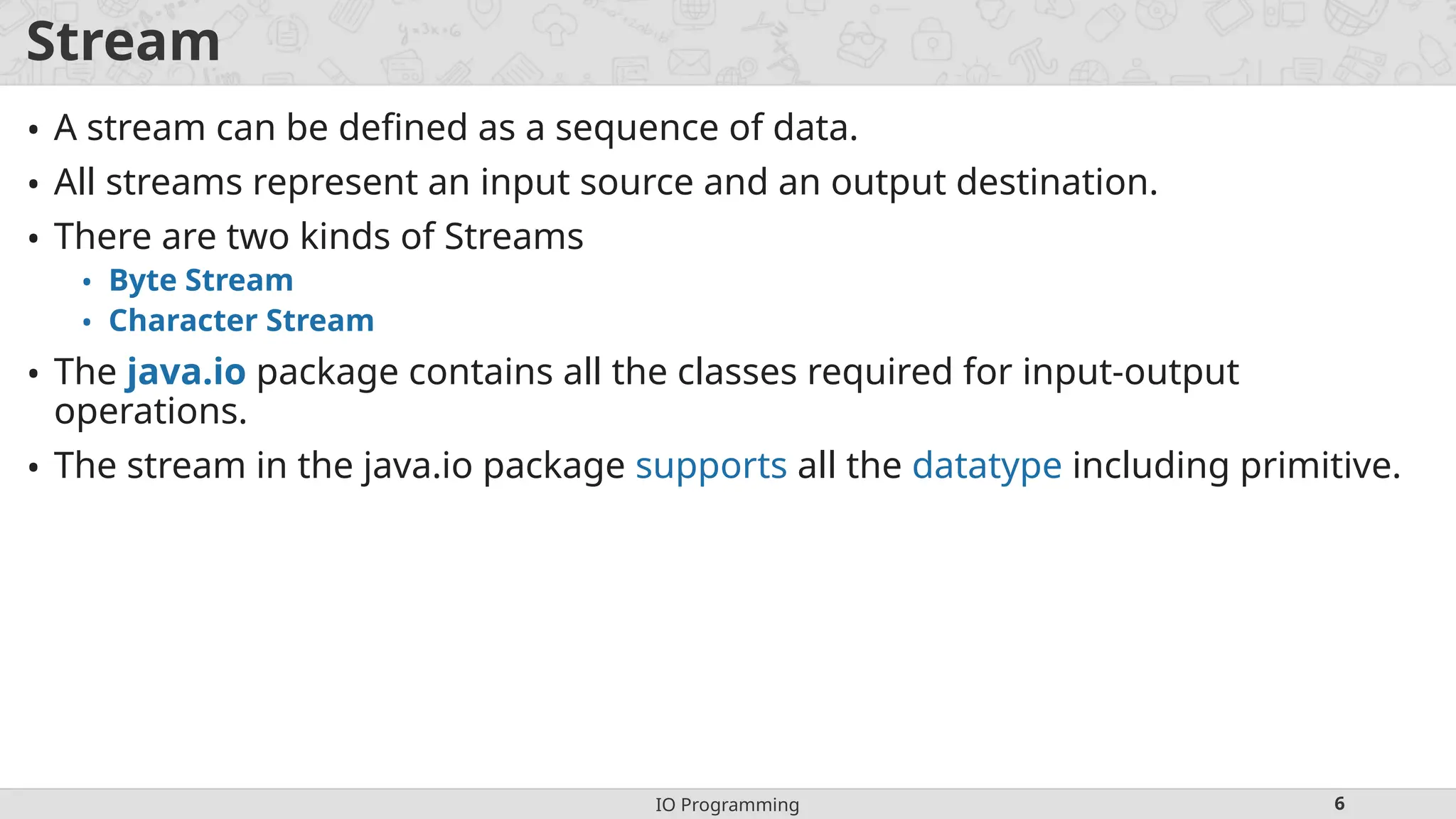
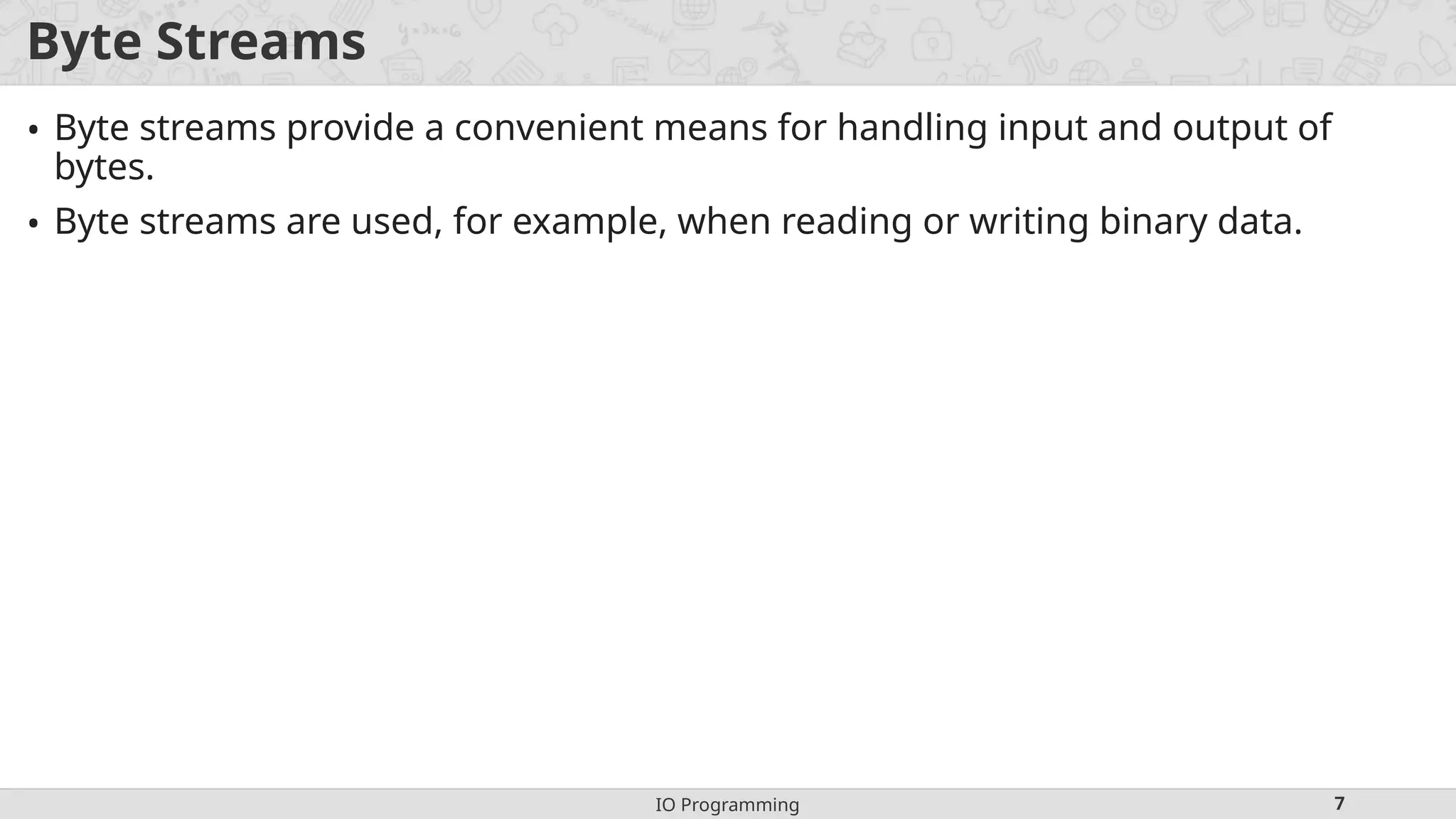
![IO Programming 8 FileOutputStream • Java FileOutputStream is an output stream for writing data to a file. • FileOutputStream will create the file before opening it for output. • On opening a read only file, it will throw an exception. Java Applicatio n 1011011101 …. File Sr. Method 1 void write(byte[] b) This method writes b.length bytes from the specified byte array to this file output stream. 2 void write(byte[] b, int off, int len) This method writes len bytes from the specified byte array starting at offset off to this file output stream. 3 void write(int b) This method writes the specified byte to this file output stream. 4 void close() This method closes this file output stream and releases any system resources associated with this stream.](https://image.slidesharecdn.com/ioprogramming-250415020335-e414d173/75/IO-Programming-pptx-all-informatiyon-ppt-8-2048.jpg)
![IO Programming 9 FileOutputStream Example class FileOutDemo { public static void main(String args[]) { try { FileOutputStream fout = new FileOutputStream("abc.txt"); String s = "Sourav Ganguly is my favorite player"; byte b[] = s.getBytes(); fout.write(b); fout.close(); System.out.println("Success..."); } catch (Exception e) { System.out.println(e); } } }](https://image.slidesharecdn.com/ioprogramming-250415020335-e414d173/75/IO-Programming-pptx-all-informatiyon-ppt-9-2048.jpg)
![IO Programming 10 FileInputStream • FileInputStream class is used to read bytes from a file. • It should be used to read byte-oriented data for example to read image, audio, video etc. Java Applicatio n 1011011101 …. File S r. Method 1 public int read() the next byte of data, or -1 if the end of the file is reached. 2 public int read(byte[] b) b - the buffer into which the data is read. Returns: the total number of bytes read into the buffer, or -1. 3 public int read(byte[] b, int off, int len) b - the buffer into which the data is read. off - the start offset in the destination array b len - the maximum number of bytes read. Returns: the total number of bytes read into the buffer, or -1 4 public long skip(long n) n - the number of bytes to be skipped. Returns: the actual number of bytes skipped. 5 public int available() an estimate of the number of remaining bytes that can be read 6 public void close() Closes this file input stream and releases any system resources associated.](https://image.slidesharecdn.com/ioprogramming-250415020335-e414d173/75/IO-Programming-pptx-all-informatiyon-ppt-10-2048.jpg)
![IO Programming 11 FileInputStream Example class SimpleRead { public static void main(String args[]) { try { FileInputStream fin = new FileInputStream("abc.txt"); int i = 0; while ((i = fin.read()) != -1) { System.out.println((char) i); } fin.close(); } catch (Exception e) { System.out.println(e); } } }](https://image.slidesharecdn.com/ioprogramming-250415020335-e414d173/75/IO-Programming-pptx-all-informatiyon-ppt-11-2048.jpg)
![IO Programming 12 Example of Byte Streams import java.io.*; public class CopyFile { public static void main(String args[]) throws IOException { FileInputStream in = null; FileOutputStream out = null; try { in = new FileInputStream("input.txt"); out = new FileOutputStream("output.txt"); int c; while ((c = in.read()) != -1) { out.write(c); } } finally { if (in != null) { in.close(); } if (out != null) { out.close(); } } } }](https://image.slidesharecdn.com/ioprogramming-250415020335-e414d173/75/IO-Programming-pptx-all-informatiyon-ppt-12-2048.jpg)
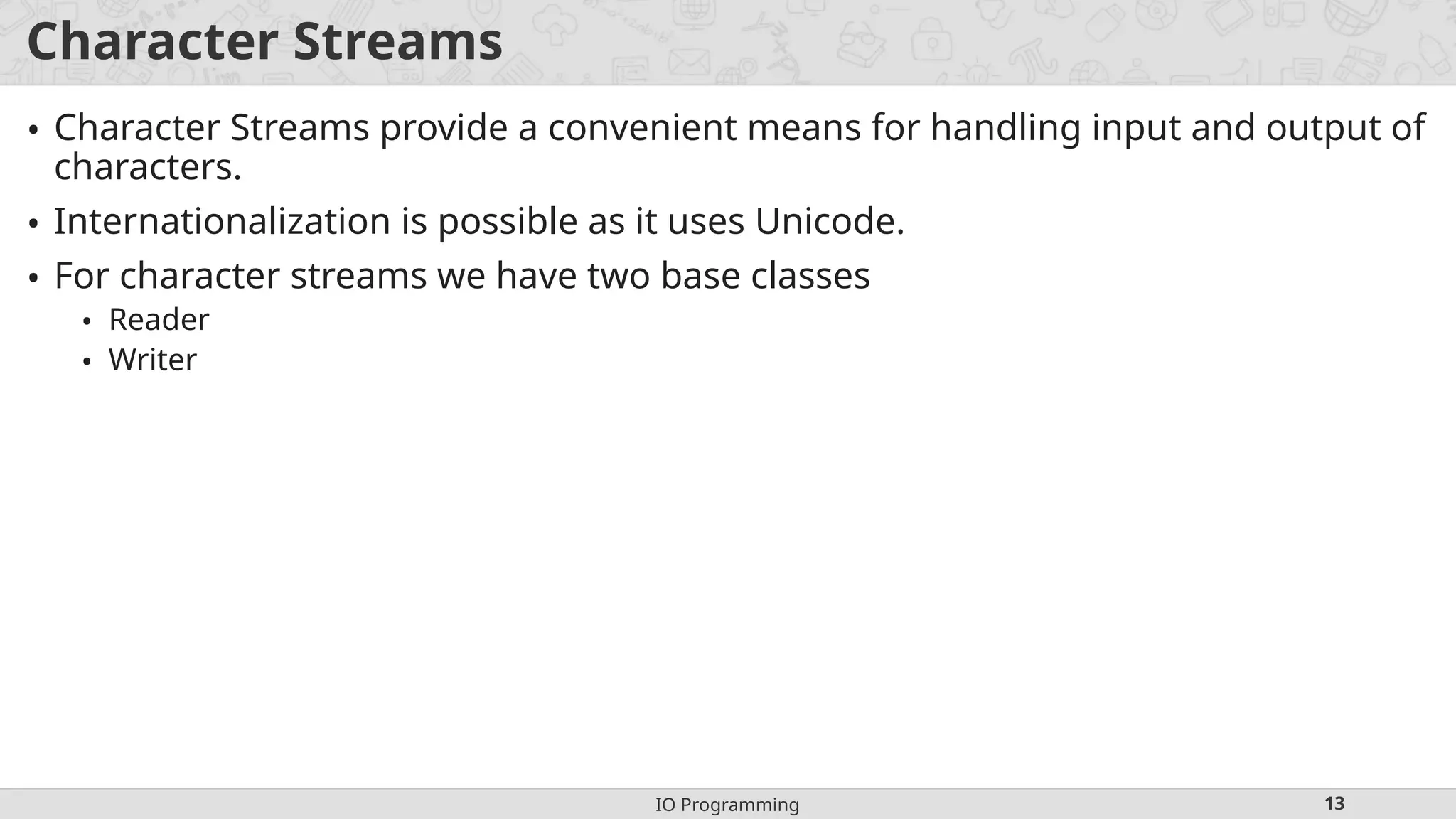
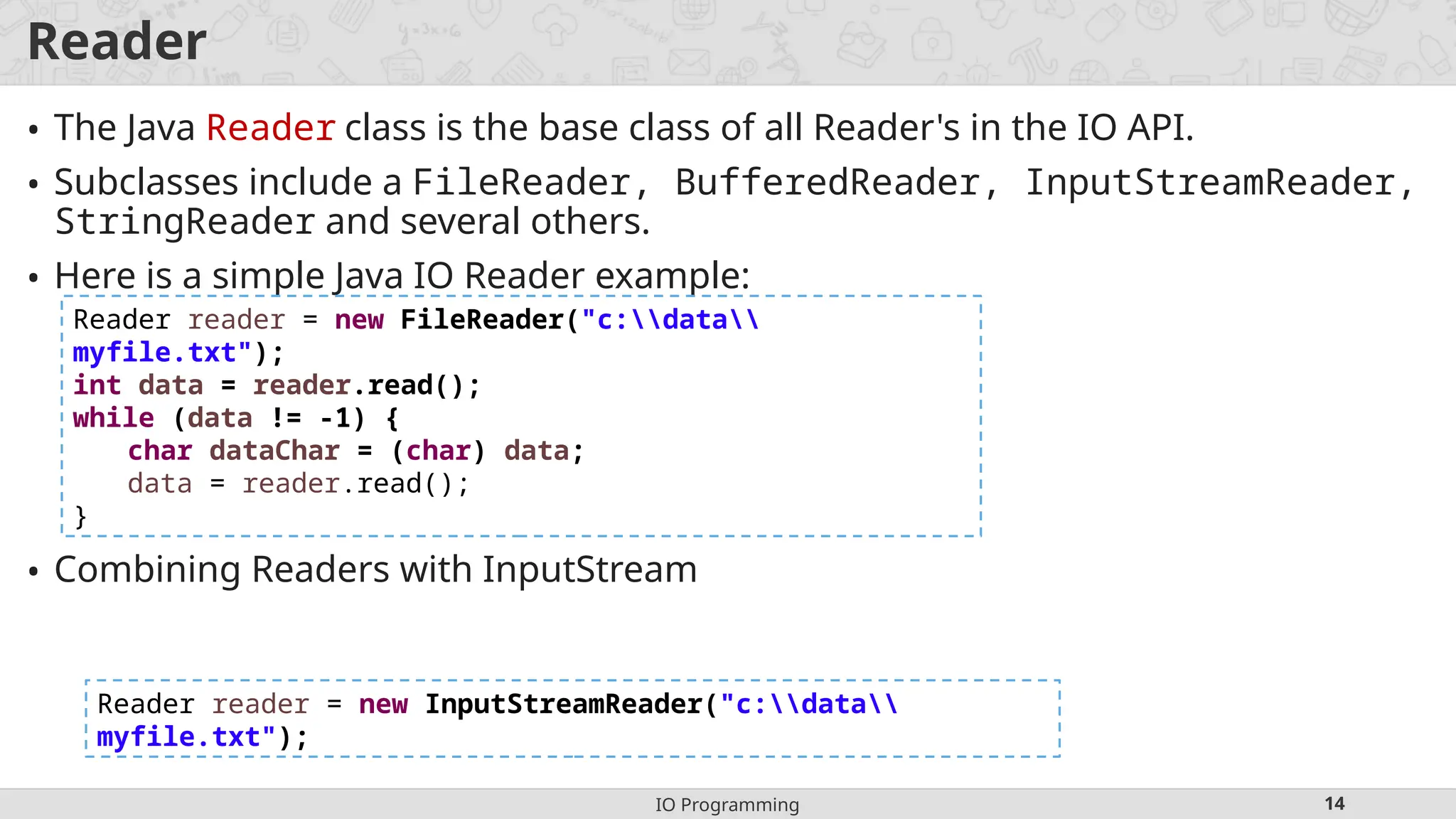
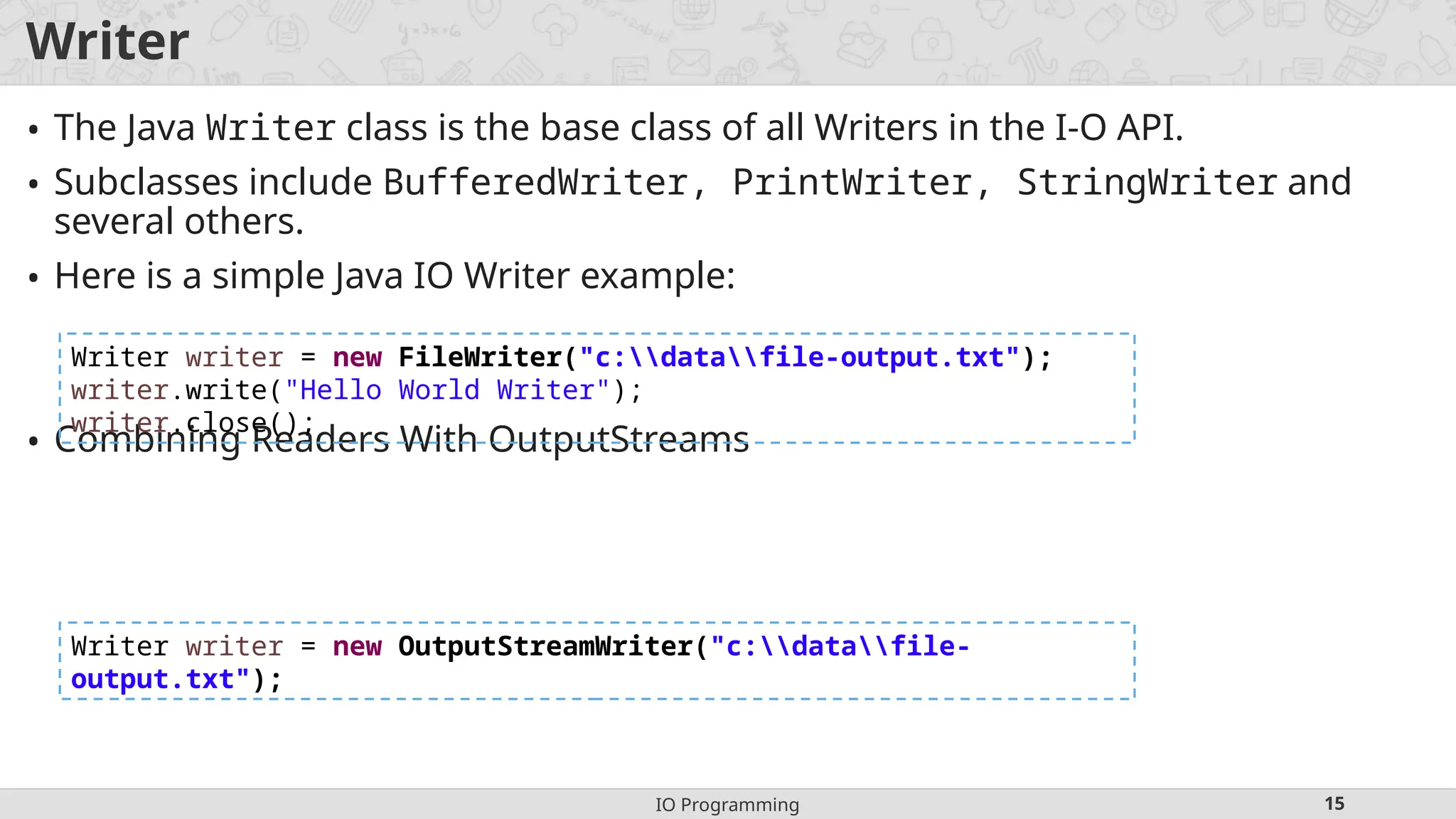
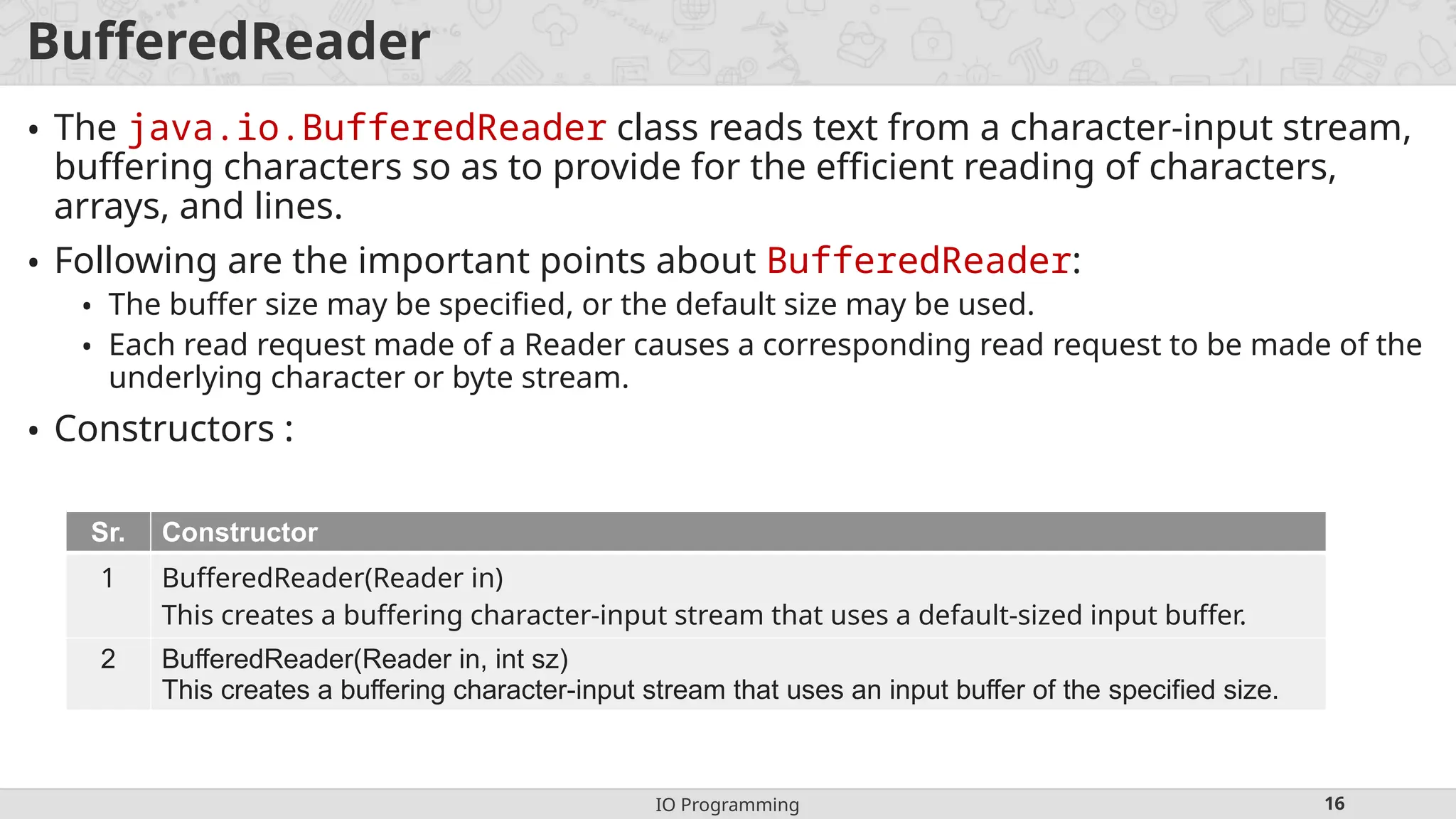
![IO Programming 17 BufferedReader (Methods) Sr. Methods 1 void close() This method closes the stream and releases any system resources associated with it. 2 int read() This method reads a single character. 3 int read(char[] cbuf, int off, int len) This method reads characters into a portion of an array. 4 String readLine() This method reads a line of text. 5 void reset() This method resets the stream. 6 long skip(long n) This method skips characters.](https://image.slidesharecdn.com/ioprogramming-250415020335-e414d173/75/IO-Programming-pptx-all-informatiyon-ppt-17-2048.jpg)
![IO Programming 18 BufferedReader – Example import java.io.BufferedReader; import java.io.FileReader; import java.io.IOException; class BufferedReaderDemo { public static void main(String[] args) throws IOException { FileReader fr = new FileReader("input.txt"); BufferedReader br = new BufferedReader(fr); char c[] = new char[20]; br.skip(8); if (br.ready()) { System.out.println(br.readLine()); br.read(c); for (int i = 0; i < 20; i++) { System.out.print(c[i]); } } } }](https://image.slidesharecdn.com/ioprogramming-250415020335-e414d173/75/IO-Programming-pptx-all-informatiyon-ppt-18-2048.jpg)